Theories for the Origin of Earth’s Radioactivity
The Hydroplate Theory. In the centuries before the flood, supercritical water (SCW) in the subterranean chamber steadily dissolved the more soluble minerals in the rock directly above and below the chamber. [Pages 126– 127 explain SCW and its extreme dissolving ability.] Thin spongelike channels, filled with high-pressure SCW, steadily grew up into the increasingly porous chamber roof and down into the chamber floor.
The flood began when the granite crust ruptured, and subterranean water escaped violently upward through the globe-encircling rupture. Pillars had to support more of the crust’s weight, because the subterranean water supported less. Tapering downward like icicles, the pillars crushed in stages, beginning at their tips. With each collapse and with each water-hammer cycle, the crust fluttered like a flag held horizontally in a strong wind. Each downward “flutter” rippled through the Earth’s crust and powerfully slammed what remained of pillars against the subterranean chamber floor. [ See “Water Hammers and Flutter Produced Gigantic Waves” on page 197.]
For weeks, compression-tension cycles within both the fluttering crust and pounding pillars generated piezoelectric voltages that easily reached granite’s breakdown voltage.81 Therefore, powerful electrical currents discharged within the crust repeatedly, along complex paths of least electrical resistance. [See Figures 209–212.]
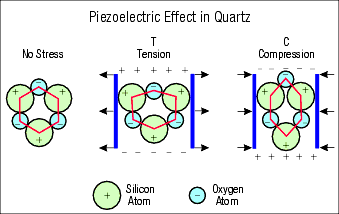
Figure 209: Piezoelectric Effect. Piezo [pea-A-zo] is derived from the Greek “to squeeze” or “to press.” Piezoelectricity is sometimes called pressure electricity. When a nonsymmetric, nonconducting crystal, such as quartz (whose structure is shown above in simplified form), is stretched, a small voltage is generated between opposite faces of the crystal. When the tension (T) changes to compression (C), the voltage changes sign. As the temperature of quartz rises, it deforms more easily, producing a stronger piezoelectric effect. However, once the temperature reaches about 1,063°F (573°C), the piezoelectric effect disappears.80
Quartz, a common mineral in the Earth’s crust, is piezoelectric. (Granite contains about 27% quartz by volume.) Most nonconducting minerals are symmetric, but if they contain defects, they are to some degree nonsymmetric and therefore are also piezoelectric. If the myriad of piezoelectric crystals throughout the 60-mile-thick granite crust were partially aligned and cyclically and powerfully stretched and compressed, huge voltages and electric fields would rapidly build up and collapse with each flutter half-cycle. If those fields reached about 9 × 10 6 volts per meter, electrical resistances within the granite would break down, producing sudden discharges—electrical surges (a plasma) similar to lightning. [See Figures 202 and 211.] Even during some large earthquakes today, this piezoelectric effect in granite generates powerful electrical activity and hundreds of millions of volts.4 [See “Earthquakes and Electricity” on page 387.]
Granite pillars, explained on page 469 and in Figure 55 on page 124, were formed in the subterranean water, in part, by an extrusion process. Therefore, piezoelectric crystals in the pillars would have had a preferred orientation. Also, before the flood, tidal pumping in the subterranean water compressed and stretched the pillars and crust twice a day. Centuries of this “kneading action” plus “voltage cycling”—twice a day— aligned these crystals even more (a process called poling ), just as adjacent bar magnets become aligned when cyclically magnetized. [See Figure 212.] Each piezoelectric crystal acts like a tiny battery—one among trillions upon trillions. So, as the flood began, the piezoelectric effect within pounding pillars and fluttering granite hydroplates generated immense voltages and electric fields. Each quartz crystal’s effective electrical field was multiplied by about 7.4 by the reinforcing electrical field’s of the myriad of nearby quartz crystals.81
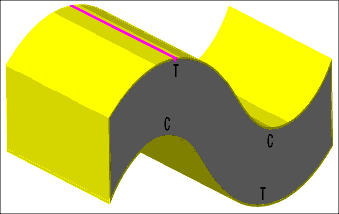
Figure 210: Fluttering Crust. Many of us have seen films showing Earth’s undulating crust during earthquakes. Imagine how magnified those waves would become if the crust, instead of resting on solid rock, were resting on a thick layer of unusually compressible water—SCW. Then, imagine how high those waves in the Earth’s crust would become if the “ocean” of water below the crust were flowing horizontally with great force and momentum. The crust’s vast area—the surface of the Earth (200,000,000 square miles)—gave the relatively thin crust great flexibility during the first few weeks of the flood. As the subterranean waters escaped, the crust flapped, like a large flag held horizontally in a strong wind.
Flutter began as the fountains of the great deep erupted. [ See “Water Hammers and Flutter Produced Gigantic Waves” on page 197.] Each time the crust arched downward into the escaping subterranean water, the powerful horizontal flow slammed into the dipping portion of the crust, creating a water hammer that then lifted that part of the crust. Waves rippled through the entire crust at the natural frequencies of the crust, multiplying and reinforcing waves and increasing their amplitudes.
Grab a phone book firmly with both hands and arch it upward. The top cover is in tension, and the bottom cover is in compression. Similarly, rock in the fluttering crust, shown above, would alternate between tension (T) and compression (C). As explained in Figure 209, huge cyclic voltages would build up and suddenly discharge within the granite crust, because granite contains so much quartz, a piezoelectric mineral. Once granite’s breakdown voltage was reached, electrical current—similar to bolts of lightning—would discharge vertically within the crust. Pillars (not shown) at the base of the crust would become giant electrodes. With each cycle of the fluttering crust, current surged through the lower crust, which was honeycombed with tiny pockets of salty (electrically conducting) subterranean water.
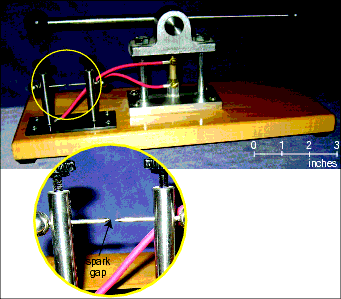
Figure 211: Piezoelectric Demonstration. When I rotate the horizontal bar of this device, a tiny piezoelectric crystal (quartz) is compressed in the vertical column just below the bar’s pivot point. The red cables apply the generated voltage across the two vertical posts mounted on the black, nonconducting platform. Once the increasing voltage reaches about 4,000 volts, a spark (a plasma) jumps the gap shown in the circular inset. When the horizontal bar is rotated in the opposite direction, the stress on the quartz crystal reverses, so a spark jumps in the opposite direction.
In this device, a tiny quartz crystal and a trivial amount of compression produce 4,000 volts and a small spark. Now consider trillions of times greater compression acting on a myriad of quartz crystals filling 27% of a 60-mile-thick crustal layer. (An “ocean” of subterranean water escaping from below that crust created water hammers, causing the crust to flutter and produce enormous compressive stresses in the crust.) The resulting gigavoltages would produce frightening electrical discharges, not through air, but through rock—and not across a little gap, but throughout the entire crust.
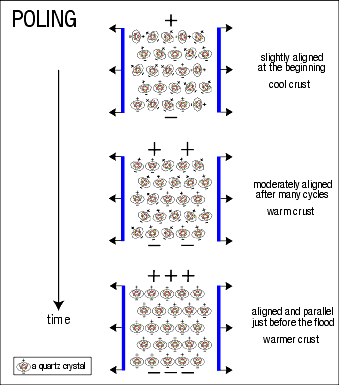
Figure 212: Poling. Poling is an industrial process that steadily aligns piezoelectric crystals so greater voltages can be produced. During the centuries before the flood, tidal stress cycles in the granite crust (tension followed by compression, twice a day)—and the electrical fields produced—applied a torque that slowly aligned the quartz crystals. (A similar picture, but with arrows and positive and negative signs reversed, could be drawn for the compression half of the cycle.) Over the years, stresses heated the crust to some degree, which accelerated the alignment process. Because so much electrical activity accompanies today’s large earthquakes, we can see that preflood poling was effective. Laboratory tests have also shown that quartz crystals still have a degree of alignment in most quartz-rich rocks.85
Electrons flowing through solids, liquids, or gases are decelerated and deflected by electrical charges in the atoms encountered. These decelerations, if energetic enough, release bremsstrahlung (BREM-stra-lung) radiation which vibrates other nuclei and releases some of their neutrons.
Neutrons will be produced in any material struck by the electron beam or bremsstrahlung beam above threshold energies that vary from 10–19 MeV for light nuclei and 4–6 MeV for heavy nuclei.82
At electrical breakdown, the energies in the surging electrons were thousands of times greater than 10–19 MeV, so during the flood, bremsstrahlung radiation released a sea of neutrons throughout the crust.83 Subterranean water absorbed many of these neutrons, converting normal hydrogen (1H) into heavy hydrogen (2H, called deuterium) and normal oxygen (16O) into 18O. Abundant surface water (a huge absorber) protected life.
During the flood, much of this 2H- and 18O-rich subterranean water was swept to the surface where it mixed with surface waters. Some subterranean water was temporarily trapped within all the mushy mineral deposits, such as salt (NaCl), that had precipitated out of the SCW and collected on the chamber floor years before the flood. Today, those mineral deposits are rich in 2H and 18O.84
The Ukrainian experiments described on page 384 show that a high-energy, Z-pinched beam of electrons inside a solid produces superheavy elements that quickly fission into different elements that are typical of those in Earth’s crust. Fusion and fission occur simultaneously, each contributing to the other—and to rapid decay. While we cannot be certain what happens inside nuclei under the extreme and unusual conditions of these experiments, or what happened in the Earth’s crust during the flood, here are three possibilities:
a. Electron Capture. Electrons that enter nuclei convert some protons to neutrons—a common event called electron capture.
Also, the dense sea of electrons reduces the mutual repulsion (Coulomb force) between the positively charged nuclei, sometimes bringing them close enough for the strong force to pull them together. Fusion results. Even superheavy nuclei form.
Self-Focusing Z-Pinch

Figure 213: Z-Pinch Discovered. In 1905, lightning struck and radially collapsed part of a hollow, copper lightning rod (shown in this drawing 87 ). Professors J. A. Pollock and S. H. E. Barraclough at the University of Sydney then showed that a strong pinching effect occurs when powerful electrical currents travel along close, parallel paths.
Later, Willard H. Bennett provided a more rigorous analysis.88 The closer the paths, the stronger the pinch—and when the flows are through a plasma, the stronger the pinch, the closer the paths. The flows self-focus.
Patents have since been granted for using the Z-pinch to squeeze atomic nuclei together in fusion reactors.
In a plasma flow, trillions upon trillions of electrical charges flow along close, parallel paths—positive charges in one direction and negative charges (electrons) in the opposite direction. The mutual repulsion of like charges doesn’t widen the paths, because the opposite charges—although moving in the opposite direction—are in the same paths. In fact, the magnetic field created by all moving charges continually squeeze (or Z-pinch) all charged particles toward the central axis. During the flood, gigantic piezoelectric voltages produced electrical breakdown in the fluttering granite crust, so each flow channel self-focused onto its axis.
In that flow, nuclei, stripped of some electrons, were drawn closer and closer together by the Z-pinch. (Normally, their Coulomb forces would repel each other, but the electrons flowing in the opposite directions tended to neutralize those repulsive forces.) Nuclei that collided or nearly collided were then pulled together by the extremely powerful strong force. Fusion occurred, and even superheavy elements formed. Thousands of experiments at the Proton-21 Laboratory have demonstrated this phenomenon. Because superheavy elements are so unstable, they quickly fission (split) or decay.
Although fusion of nuclei lighter than iron released large amounts of nuclear energy (heat), the fusion of nuclei heavier than iron absorbed most of that heat and heat released by fission and decay. This also produced heavy elements that were not on Earth before the flood (elements heavier than lead, such as bismuth, polonium, radon, radium, thorium, and uranium). The greater the heat, the more heavy elements formed and absorbed that heat. A heavy flux of neutrons accompanied this production, so nuclei absorbed enough neutrons to make them nearly stable. This is why the ratios of the various isotopes of a particular element are generally fixed. These fixed ratios are seen throughout the Earth, because the flood and flux of neutrons were global.
b. Shock Collapse.86 Electrical discharges through the crust vaporize rock along very thin, branching paths “drilled” by gigavolts of electricity through extremely compressed rock. Rock along those paths instantly becomes a high-pressure plasma inside thin rock channels. The shock wave generated by the electrical heating suddenly expands the plasma and the surrounding channel walls, just as a bolt of lightning expands the surrounding air and produces a clap of thunder. As that rock rebounds inward—like a giant, compressed spring that is suddenly released—the rock collapses with enough shock energy to drive (or fuse) nuclei together at various places along the plasma paths. This frequently happens deep in the crust where the rock is already highly compressed.
Superheavy elements quickly form, fission, and decay into such elements as uranium and lead. The heat released propels the plasma and new isotopes along the channels. As the channels contract, flow velocities increase. The charged particles and new elements are transported to sites where minerals are grown, one atom at a time.
c. Z-Pinch. As explained on page 378 and in , the path of each electrical charge in a plasma is like a “wire.” All “wires” in a channel are pinched together, but at each instant, pinching forces act only at the points occupied by moving charges, and each force is the sum of the electromagnetic forces produced by all nearby moving charges. Therefore, the closer the “wires,” the greater the self-focusing, pinching force, so the “wires” become even closer, until the strong force merges (fuses) nuclei.
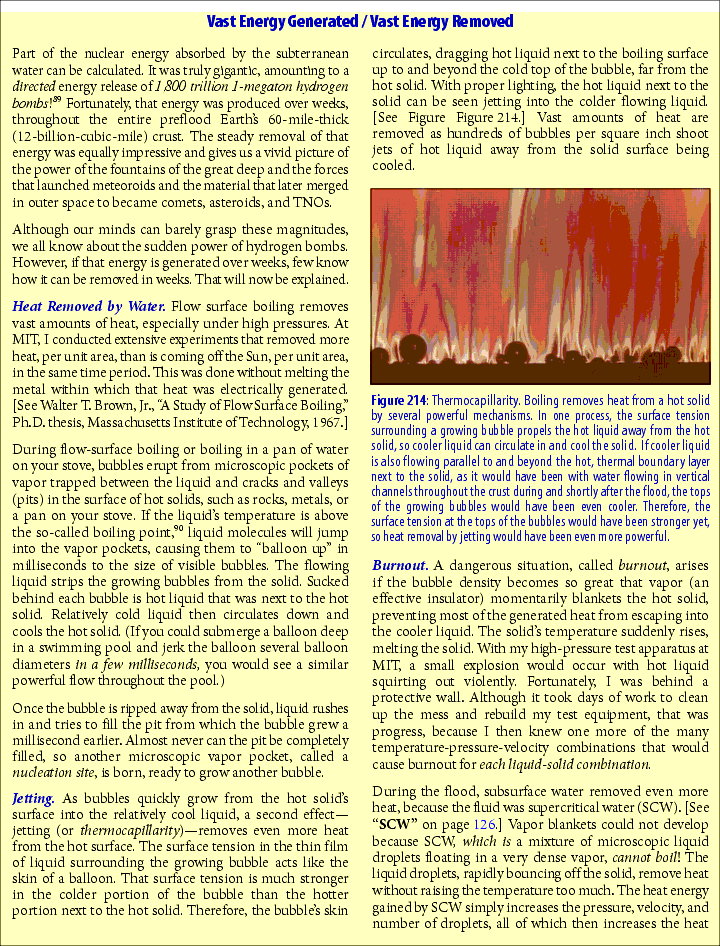
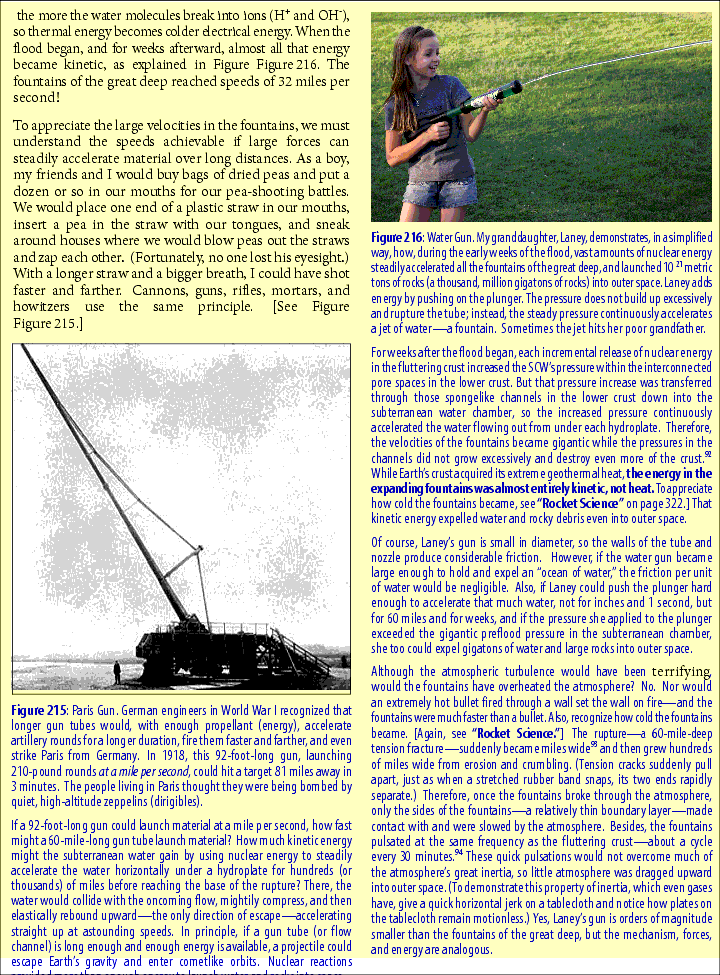
All three mechanisms are probably at work, although c is experimentally demonstrated by the 21 billion dollar TOKAMAK (a Russian acronym) jointly developed by the United States, France, Korea, Russia, the European Union, Japan, India, and China.
For centuries before the flood, SCW dissolved the more soluble minerals in the chamber’s ceiling and floor. The resulting spongelike openings then filled with SCW. During the flood, that pore water provided an enormous surface area for slowing and capturing neutrons and other subatomic particles. Great heat resulted, some becoming Earth’s geothermal heat. Simultaneously, electrical discharges “drilled” thin plasma channels within the crust, producing other nuclear reactions and additional heat.

For weeks, all this heat expanded and further pressurized the SCW in the spongelike channels in the lower crust, slowly forcing that water back into the subterranean chamber. Therefore, higher than normal pressures in the subterranean chamber continuously accelerated the escaping subterranean water, much like a water gun. [See Figure 216.] Velocities in the expanding fountains of the great deep reached at least 32 miles per second , thereby launching the material that became comets, asteroids, meteoroids, and TNOs! [See page 318.]
Heat added to SCW raises temperatures only slightly, for three reasons.
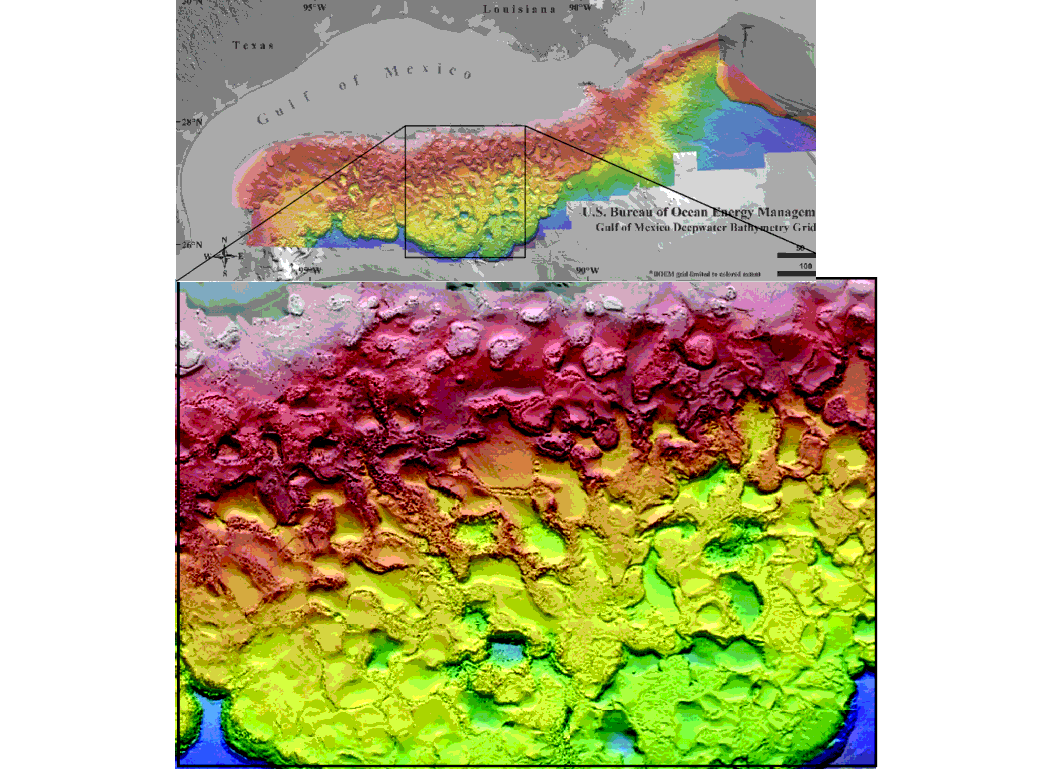
Figure 217: Gulf of Mexico. The 135-mile-wide square in the top map is expanded in the bottom map to show a detailed three-dimensional view of the pockmarked floor in the Gulf of Mexico. Each pixel covers an area on the sea floor the size of a typical home. Because the mushy, mother salt layer is so fluid, it eventually pooled at the lowest possible depths. Early during the flood, the pulsating, high-pressure subterranean water broke through the granite crust. Sediments almost 30,000 feet thick were then deposited on top of the 1,000-foot-thick mother salt layer. Weight imbalances forced the more buoyant salt to rise through the denser (still mushy) sediments as salt domes—mountains of salt, some taller than Mount Everest. Depressions formed in other places as the salt that was directly below the pockmarks flowed laterally and fed into the bases of nearby, rising salt domes. Huge salt deposits also underlie the Mediterranean seafloor.
If you look at a globe, doesn’t it appear that a circular region of the Americas’ hydroplate was blown out to form the Gulf of Mexico and part of the Europe /Africa/Asia hydroplate was blown out to form the Mediterranean Sea? What about the Black Sea, the Arctic Ocean, and the Caribbean?
1. Liquid quickly evaporates from the surface of the myriad of microscopic droplets floating in the supercritical vapor. We see surface evaporation on a large scale when heat is added to a pan of water simmering on the stove at 212°F (100°C). The water’s temperature does not rise, but great volumes of vapor are produced.
2. As heat was steadily added, positive and negative electrical charges (ions) were increasingly produced and separated. Therefore, more and more energy was stored electrically, so temperatures rose very little. As water escaped upward during the flood and temperatures and pressures dropped, those electrical charges recombined and the energy was recovered with almost 100% efficiency.
3. As more heat was added to the escaping SCW, the fountains accelerated even more. With that greater acceleration came greater expansion and cooling.
Nuclear energy primarily became electrical energy and then kinetic energy. Had the nuclear energy produced heat only, much of the Earth would have melted.89 Also remember, quartz piezoelectricity shuts off at about 1,063°F (573°C).
Chemical Evolution Theory. The current evolutionary theory for the formation of chemical elements and radioisotopes evolved from earlier theories. Each began by assuming a big bang and considering what it might produce. Years later, fatal flaws were found.
Initially (in 1946), George Gamow, a key figure in developing the big bang theory, said that during the first few seconds after the universe’s hot expansion began, nuclear reactions produced all the chemical elements.103 Two years later, Gamow retracted that explanation. Few heavy elements could have been produced, because the expansion rate was too great, and the heavier the nuclei became, the more their positive charges would repel each other.104
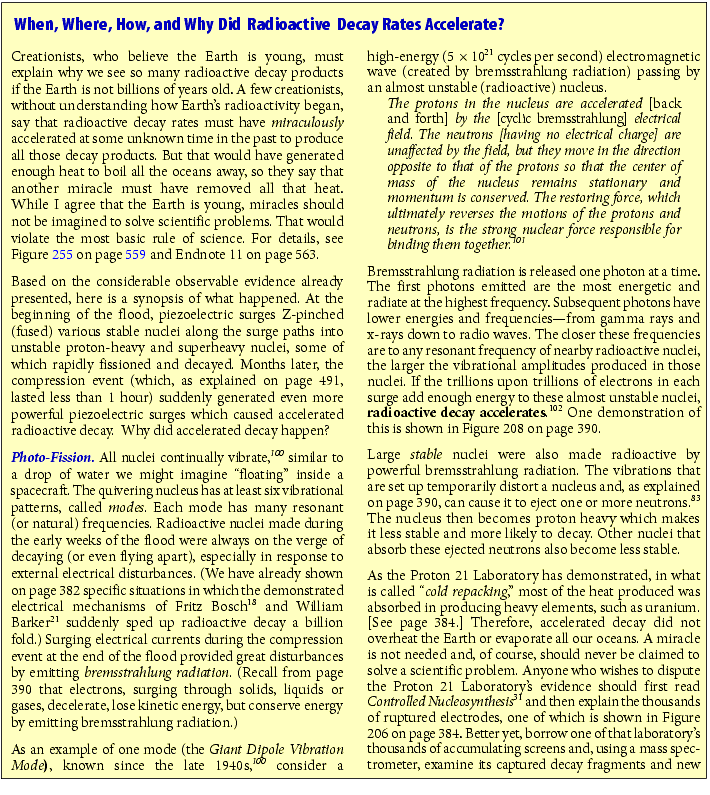
In 1948, the follow-on theory assumed that a big bang produced only neutrons.107 A free neutron decays in about 10 minutes, becoming a proton, an electron, and a particle (an antineutrino) that we can disregard in this discussion. Supposedly, protons and neutrons slowly merged to become heavier and heavier elements. Later, that theory was abandoned when it was realized that any nucleus with a total of five or eight nucleons (protons or neutrons) would decay and lose one or more nucleons in about a second or less.108 Simply stated, growing a nucleus by adding one nucleon at a time encounters barriers at 5 and 8 atomic mass units.
The next theory said that a big bang produced only hydrogen. Much later, stars evolved. They fused this hydrogen into helium, which usually has four nucleons (two protons and two neutrons). If three helium nuclei quickly merged, producing a nucleus weighing 12 AMU, these barriers at 5 and 8 AMU could be jumped. This theory was abandoned when calculations showed that the entire process, especially the production of enough helium inside stars, would take too long.
A fourth theory assumed that two helium nuclei and several neutrons might merge when helium-rich stars exploded as supernovas. This theory was abandoned when calculations showed that to produce only the required helium, stars needed to generate much more heat than they could produce in their lifetimes.109
The current evolutionary theory for Earth’s radioactivity, first proposed in 1952, has the big bang producing only hydrogen, helium, and a trace of lithium. Inside stars, two helium nuclei sometimes merge briefly (for about 7 × 10-17 of a second—less than a billionth of a ten-millionth of a second). If (and what a big “if ” that is !), during this brief instant, a third alpha particle merges with the first two, carbon will be formed. But how that triple-alpha process could happen is a mystery.
But exactly how each of these reactions happens at a fundamental level remains unexplained [because all the colliding positively charged nuclei would repel each other].110
This mechanism has not been verified experimentally or computationally.111 Why then, with no scientific support, is this mechanism taught as if it were a fact? Chemical elements had to form somehow. If they did not “evolve,” how did chemical elements get here? This mechanism, as with all prior guesses that were taught widely and are now rejected, is born out of desperation, because creation, the alternative to chemicals evolving, is unacceptable to many.
Even if this problem did not exist, only chemical elements lighter than 60 AMU could be formed—by adding more protons, neutrons, and alpha particles (but only if stars had somehow formed). Pages 27–35 explain why stars, galaxies, and planets would not form from the debris of a big bang.
Assuming the formation of stars and the highly improbable triple collision of alpha particles at a rapid enough rate, stars “burning” hydrogen for billions of years might theoretically produce the rest of the 26 or so lightest chemical elements. But fusion inside stars must stop when nuclei reach about 26 AMU. How the 68 other naturally-occurring chemical elements (those heavier than iron) were produced is not known.114 Charles Seife explains:
We are all made of starstuff. The big bang created hydrogen, helium, and a little bit of lithium and other light atoms. But everything else—the carbon, oxygen, and other elements that make up animals, plants, and Earth itself—was made by stars. The problem is that physicists aren’t quite sure how stars did it.115
Temperatures hundreds of times greater than those occurring inside stars are needed.116 Exploding stars, called supernovas, release extreme amounts of energy. Therefore, the latest chemical evolution theory assumes that supernovas produced the heavier chemical elements and then expelled them into the vacuum of space. By this thinking, radioactive atoms have been present throughout the Earth since it, the Sun, and the rest of the solar system evolved from scattered supernova debris. But Earth’s mantle has little if any, radioactivity
[Response: Observations117 and computer simulations118 do not support this idea that supernovas produced all the heavy chemical elements. The extreme explosive power of supernovas should easily scatter and fragment nuclei, not drive nuclei together. Remember, nuclei heavier than iron are so large that the strong force can barely hold on to their outer protons. Also, the theoretical understanding of how stars and the solar system formed is seriously flawed. See pages 27–35.]